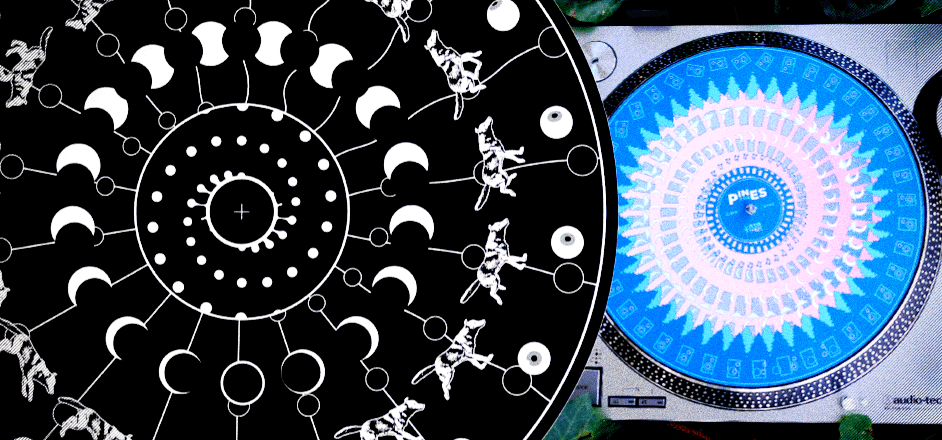For some, “going viral” means quickly losing a good job and becoming the poster adult for bad behavior. For others, like visual artist Tee Ken Ng, having millions view his creativity within minutes was something fairly unexpected — but appreciated nonetheless.
“It all came about from a video I made for Eristoff Vodka last year,” says Ng of his popular phenakistoscope*. They’re like vinyl records with printed animation cells; interactive art that completely transforms the experience of listening to music on a turntable.
The video got so popular online he immediately began receiving messages from musicians and record labels to commission custom clip mats and vinyl of their own. One of his other popular vinyls — a running cat he made for Dope Lemon’s Smooth Big Cat (shown further below) — regularly appears on popular weed-friendly Instagram accounts. It’s not hard to see why.
The @eristoffvodka slipmat is now available to download! Print it out, cut it out & try it out. Enjoy! x
https://t.co/XxTpDi0AzM pic.twitter.com/aGkcLm3yee— Tee Ken Ng (@teekenng) November 22, 2018
So what exactly is it you do for a living and how did animating vinyl become a thing for you?
I do a few different things; I usually just say I’m a graphic designer as most people know what that is. I'm also a video producer, stop motion animator and visual artist. I have created videos for Google, Netflix, Twitter, Perrier, Virgin Mobile and others. More recently I’ve become known as 'that animated vinyl guy.' As Eristoff are involved in the underground dance music scene and host Boiler Room events I thought it’d be cool to create an animation on a DJ slip mat and film it for the video. To my surprise the video blew up and I was inundated by people messaging me wanting to know how they could get the slip mat they saw in the video. I also started getting offers from musicians and record labels wanting their own custom designed animated slip mats and vinyl.
If you can, briefly explain how all this works.
Creating animations on a disc is actually one of the oldest techniques of animating. A device known as the phenakistiscope was invented by Joseph Plateau in the 1800s. It consisted of a flat spinning cardboard disc with the frames of an animation printed around it. The animation works when the disc is spun and viewed through the evenly spaced cut-out slits in the cardboard. The principle is exactly the same for animating on a vinyl but instead of viewing it through slits you can use the shutter on a camera or phone to create the same effect. By knowing the speed of rotation (either 33 1/3rpm, 45rpm, or 78rpm on a turntable) and what frame rate you want to record at (ie. 24fps) you can calculate how many frames or slices (like a pizza) your animated disc needs to be divided into.
The interesting thing about animating in this way is that all the frames in your animation are visible all together, unlike film where you only see a single frame at a time. I find this is the most challenging thing to get your head around but is also what makes it look so mind bending when it works. You literally see a static picture come to life as it starts spinning.
So, it's not like you'll see the animation with your eyes, but you'll need a phone to make it happen?
Yes exactly, the camera acts like the shutter in a film projector or the slits you look through to view a phenakistiscope or zoetrope. Without it all you’ll see is a blur. Alternatively, if you want to see it just with your eyes you could use a strobe light but they tend to make some people nauseous.
Is vinyl design your main job, or are you involved with other forms of art creation?
Vinyl design is not my main job but I do really enjoy the process of making them and love that people can get them and interact with them. The recent Dope Lemon vinyls I designed sold out around the world with the video I made of them also doing the rounds on the Internet. It was really cool to see so many people posting their own videos of the vinyl animating on their turntables too. However, I’m a little wary about only being known as a vinyl designer, as a result I’m pretty selective as to who I work with. All of the animated vinyls and slip mats I’ve made can be found on my Instagram. Keep an eye out for some upcoming ones which have release dates in the near future.
You've made 'DIY' cutouts in the past, do you plan on doing any more in the future?
I am actually doing massive amounts of cutouts at the moment for a music video in the works which will be released next year. Unfortunately I can’t say much more than that.
What else would you like our readers to know about you and your craft?
What I love most is creating videos that involve practical effects (as opposed to VFX) and stop motion animation to make viewers question what they are seeing and wonder how it was done. I thought an animated vinyl would be a cool practical effect for a video, I didn’t realise people would actually want them!
—–
























Leave a Reply
You must be logged in to post a comment.